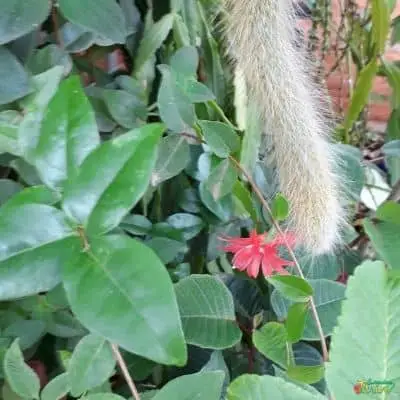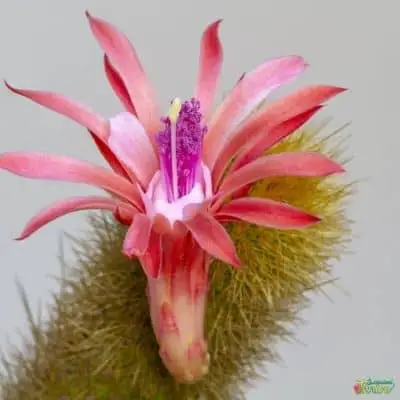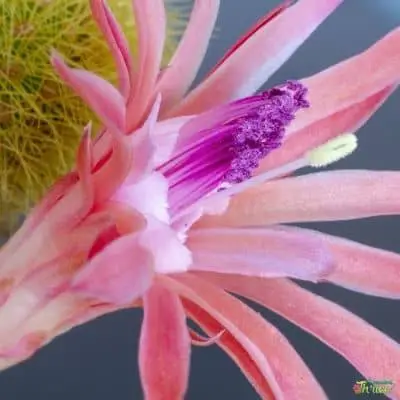The plant belongs to the Cactaceae family, genus Cleistocactus, a group of succulent perennial plants, which occur in the north and south Americas. Monkey tail cactus is endemic to Bolivia’s Santa Cruz mountainous regions. In the form of the stems of the cacti in this genus expand like columns. The name of the genus refers to the ‘closed’ aspect of the occasionally entirely open flowers.
The Monkey Tail is known as a Lithophyte, as it has shallow roots and spreads naturally between stones and cliff crevices, surviving from the ambient humidity.
Over the years, the Monkey Tail Plant has seen a few botanical name updates. It is now referred to as Cleistocactus winter. Hilderwintera colademononis, Wisteria aureispina, and Winterocereus crispiness were its former names.
With all the hair-like spines hanging above the edge, this is a perfect plant to grow in a hanging basket. In general, cactus plants are known to have branches packed with water and dense leaves, so they require little maintenance to live. And if you have trouble growing plants, they make a perfect houseplant.

How do I identify a monkey tail cactus?
There is a thick layer of gold to silver spikes on the ribbed, fleshy, mid-green leaves. This makes them look cute, like a monkey’s tail and hairy. The stems would at first grow erect, then they will become pendants as they age.
Eventually, the stems can spread and cross over with the proper care and form a most beautiful branching cacophony. In the warmer months of spring and summer, the flowers are vivid, salmon red and can grow up to 5 cm in width and they open along the stems. Each bloom lasts three days or more. You prefer to get the best flowers when the winter weather is a little cold.
Care of a monkey tail cactus
| Botantical name (present) | Cleistocactus winteri |
| Botanical names (old) | Hilderwintera colademononis, Winteria aureispinar, Winterocereus aueispinus |
| Height | 20-200cm |
| Width | 20-200cm |
| Flowers | Spring to Summer |
| Climate | Cool to Tropical |
| Zone | 9a to 11b : from 20 degrees Fahrenheit (-6.7 degrees of Celsius) to 50 degrees Fahrenheit (10 degrees of Celsius). |
| Soil pH | Acidic or near neutral (5.5-6.5) |
| Soil type | loamy and sandy |
| Availability | Australia wide |
| Frost hardiness | Frost Tender |
| Aspect | Filtered Light |
| Supplied as | Pots |
| Size | 7.5 cm |
| TOXICITY | Does not specify whether they are toxic to humans and wildlife |
How do you take care of a monkey tail cactus?
1.SIZE
the Monkey Tail Cactus can expand a few feet before they begin to droop. They can rise to 12-18 inches on average until they begin to decline.
2.GROWTH
Monkey tail cactus is rising and growing very quickly and very aggressively. The stems or ‘tails’ will grow up to 10 cm per month in spring and summer. The stems can reach 7.5 cm in diameter when grown, and grow as long as 2.5 meters long.
3. LIGHT Requirement
It does not need direct sunlight, and furthermore needs bright indirect light and some shade. But The Monkey Tail is a yellowish-green color which, with 10-14 hours of direct sunshine, can do well.
The sexual cycle can be triggered by light as well. In spring, buds will emerge and the plant will flower for much of spring and summer. This is an ideal time for the plant to be propagated by pollination.
4. Temperature and humidity
Hot temperatures are required for the Monkey Tail Cactus, but they can live in temperatures below zero.
The humidity levels to which the plant is subjected need to be regulated in an indoor environment along with its levels of illumination, temperature, and watering. In summer, the plant can use the moisture in the atmosphere to spur its development when it is humid. In winter, however, too much humidity will have the effect of overwatering the plant, like too much water on its roots, which will allow its cells to become waterlogged and rot. Excess humidity in a closed atmosphere with low ventilation provides the perfect environment for mold to spread. This disease thrives on organic matter that is rotting.
Is it cold hardy?
The Monkey Tail Cactus can survive below-freezing temperatures.
Hardiness zone
The Hardiness zone of Crassula ‘’Springtime’’ is 9a to 11b: from 20 degrees Fahrenheit (-6.7 degrees of Celsius) to 50 degrees Fahrenheit (10 degrees of Celsius).
(A hardiness zone is a geographically defined region in which, as defined by climatic conditions, a certain type of plant life is able to expand, including its ability to withstand the minimum temperatures of the zone)
Watering Requirement
Watering impacts the development of the Monkey Tail, much like the light levels to which it is exposed. Before watering the plant again, still, spray thoroughly and let the soil dry out entirely. Shallow watering would allow the roots to expand towards the surface, allowing the soil to retain less.
The plant only needs enough water during winter to support it in its dormant condition. Watering thoroughly, every 6-8 weeks should be enough.
When spring approaches, the watering frequency steadily increases. The roots can consume as much as is required by the plant. Ensure all the water drains away from the remainder.
Soil Requirement Type / pH
In soil that is acidic or near neutral, cacti tend to expand. The monkey tail cactus grows best in the soil that has a pH level ranging from 5.5 to 6.5.
Cactus prefer soil that can easily drain. When a cactus mix isn’t used, the soil has to be light and well aerated. This means that it has to be loamy and sandy. Just when it is actively growing would you need to fertilize it.
Liquid plant food can contain high levels of potassium and low levels of nitrogen. Dilute with water the fertilizer so that you can use it to administer it as a vapor.
Flowering and Fragrance
Monkey tail cactus flowers are large bright red flowers with long, white, delicate, hair-like spines as long as 3 inches. The Monkey Tail cactus flowers turn into reddish, spherical seeds that quickly germinate.
Flowers survive for a couple of days before transitioning to fruit for a brief period of time. Silver/grey, cream/tan, light, black, or medium green can be the foliage. Flowering usually occurs in spring and summer, but depending on the climate, the plant can flower in autumn or even winter.

Pot size Potting and Repotting
As the roots are shallow, the Monkey Tail does not take much depth. The number of plants you want to bring in will decide the width of the container.
Repotting of Monkey tail cactus can be done after the end of the growing and flowering season is completed. To replenish the soil, it is recommended that the plant be reported every three years.
You’ll need a larger planter with a fresh soil mix if you’re reporting a mature cactus. Increasing the size of the pot would not be appropriate unless you are thinking of increasing the number of individual plants in it.
You ought to get manure added in and properly aerated for the fresh soil. To expand and prosper, the new cuttings need a lot of nutrients. Make sure the pot you are using gives them plenty of room for their roots.
Fertilizer and time of year
They do not need much fertilizing, as with watering. It should be enough once a season, during spring, summer and fall.
Low nitrogen or foliar feed components are needed in spring and summer, along with a significant amount of phosphorus, to promote the growth of flowers, seeds, and fruit. Potassium is also needed to reinforce the stems and increase the overall health of the plant.
Dormancy
When a Monkey Cactus needs to “rest” in a cool region for a few months during late fall and winter. For it to bloom well, this dormant cycle is required.
Other plants Pairs Well With..
In most cases, you will grow succulents along with cactuses. Yet, you need to know the varieties well to make sure there are no special conditions on all of them.
Can be toxic to pets
It does not specify whether they are toxic to humans and wildlife, but it would be advisable to keep them out of the hands of pets and children with cactus needles.
Common bugs and illness issues
-
Root rot
Root rot can happen due to overwatering. So, you must pay attention to watering in enough amounts.
-
Spider mites
You very rarely realize that you have them before the plant is weakened to almost disfigurement. They are probably mites if you find any brown stains on the cactus. With good watering and pumping up the moisture by continuously fogging your plant, you will scare them away.
-
Scales
You will have to use a gentle toothbrush coated on them in rubbing alcohol and wipe all the infected leaves to get rid of them because they lock to the leaves’ surface and you can’t get them off any other way in order to get rid of them.
-
Mealybugs
These can be taken care of by using a soapy water mixture spray or a Neem Oil spray that can be gently sprayed with the same mixtures once a week to help prevent them from returning or beginning in the first place. To wipe these bugs down, you can also use your water hose.
Special Care tips
- This cactus does not need to be trimmed, so you should carefully pick any dead flowers.
- As you choose to improve the appearance and use for propagation, eliminate offsets or small branches.
- The tendrils can, sometimes, die off naturally. Remove them when required.
How do you propagate a monkey tail cactus?
The main way to propagate a Monkey Tail Cactus is to lop a slice off the end of the tail, allow it to dry, and then plant it deep in dry soil for around a centimeter. Taking root and beginning to grow a new plant could take a month. Branches or ‘pups’ will invariably emerge at the end of the tail that has been removed, which will look strikingly like fingertips. Like cuttings, these pups may be twisted off and propagated in the same manner.

monkey tail cactus plant benefits
- For beginner gardeners, it is a reasonable alternative.
- It does well in a hanging basket as a houseplant.
- The plants and red flowers in zones 9a-11b make a good addition to a rock garden, and in a sunny environment, it will bring a lot of visual appeal to a casual rock wall.
Credits to Desert Plants of Avalon
Do monkey tail cactus need direct sunlight?
It does not need direct sunlight, and furthermore needs bright indirect light and some shade but, with 10-14 hours of direct sunshine, can do well.
READ Graptoveria ‘Fred Ives’ Succulent Care
